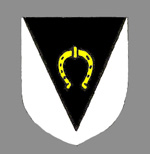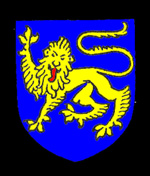The Manor of Crawley

The coat of arms of Dunstable Priory
The histories of manors in Husborne Crawley are given in Volume III of The Victoria County History for Bedfordshire published in 1912. Crawley Manor, later also, confusingly, called Husborne Crawley Manor, was held by William Lovett at the time of the Domesday Book of 1086. The overlordship passed to the Earls of Albermarle in the mid 13th century until 1368 when Robert de Lisle released the overlord's rights to the Crown. Later overlords were the canons of Dunstable.
Lovett had no tenant in 1086 and the first known tenant of the manor, owing fealty to the overlord, was Philip de Saunvill in about 1170, when he granted the advowson of the church to Dunstable Priory. By the mid 13th century the manor was held in two halves, one by Nicholas de Tingry and the other by David de Flitwick. Nicholas de Tingry released his lands in Husborne Crawley, except for a mill and half a virgate of land, to Dunstable Priory in 1248. The prior later built a grange (a manor house belonging to a manor held by a religious foundation), two sheepfolds and a cowhouse on the manor lands. The Countess of Albermarle, as overlord, reckoned that the priory had not paid homage and had received the manor without licence and so twelve ploughing oxen were seized as penalty and held for twelve weeks. Peace was only made on payment of 5 marks (£3/6/8) and a further 20 shillings (£1). In 1276 the prior's estate was surveyed as 2½ hides.
David de Flitwick died in 1247 and was succeeded by two more of his family, Bartholomew de Flitwick holding half the manor in 1276. Another Bartholomew proved to be a felon and the manor was seized by the Crown for a year and a day before being restored to another David de Flitwick in 1311 when the estate was described as a messuage (dwelling) and a carucate of land. About 1358 David de Flitwick devised his half of the manor to Dunstable Priory.
The Prior of Dunstable continued to be Lord of the Manor until the priory was dissolved by King Henry VIII in 1541. A Christopher Smith considered buying the manor in 1550 when it was valued at £195/15/5 but in the end he did not do so. At a date before 1597 John Thompson acquired the manor. He also acquired the Manors of Brays and Husborne Crawley, uniting them for the remainder of their history.

The Thompson family coat of arms
The manor remained in the Thompson family until 1691 when Saint John Thompson conveyed it to John Lowe. His successor Francis conveyed the manor to the Duke of Bedford in 1721 for £2,750. The manor house and advowson were not sold along with the manor and were purchased by Edmund Williamson after Sir John Thompson's death in 1710. Williamson died in the manor house in 1737 and his son Talbot continued his father's policy of buying up land in the parish. He was succeeded by his wife, who died in 1792 and their son sold manor house, estate and advowson to Francis, 5th Duke of Bedford in 1794 for £9,444. The Duke promptly had the manor house pulled down. As the map of 1760 below [R1/42] shows, the manor house lay on the west side of School Lane just south of Crawley Brook. Soil disturbances can be seen on aerial photographs and satellite imagery representing both the site of the manor and Terras Walk which ran past the south front.
![The old Crawley Manor house in 1760 [R1-42]](/CommunityHistories/HusborneCrawley/HusborneCrawleyImages/The old Crawley Manor house in 1760 [R1-42]_135x301.jpg)
The old Crawley Manor house in 1760 [R1/42]
Crawley Manor continued to be owned by the Dukes of Bedford into the 20th century. A succession of Law of Property Acts in the 1920s extinguished all manorial incidents, courts and copyhold tenure of land. This effectively abolished manors in all but name.
 View towards the site of Crawley Manor January 2012
View towards the site of Crawley Manor January 2012